Fr: Hirondelle à front blanc
Ang: Cliff Swallow – American Cliff Swallow
All: Fahlstirnschwalbe
Esp: Golondrina Risquera
Ita: Rondine rupestre americana
Nd: Amerikaanse Klifzwaluw
Sd: Stensvala
Photographers:
Roger Ahlman
Pbase Galleries Peru and Ecuador
Tom Grey
Tom Grey's Bird Pictures
Tom Merigan
Tom Merigan’s Photo Galleries
Text by Nicole Bouglouan
Sources:
HANDBOOK OF THE BIRDS OF THE WORLD Vol 9 - by Josep del Hoyo - Andrew Elliot - David Christie - Lynx Edicions - ISBN: 8487334695
A GUIDE TO THE BIRDS OF COLOMBIA by Steven L. Hilty and William L. Brown - Princeton University Press – ISBN 069108372X
A GUIDE TO THE BIRDS OF MEXICO AND NORTHERN CENTRAL AMERICA by Steve N. G. Howell, Sophie Webb - Oxford University Press - ISBN: 0198540124
BIRDS OF SOUTH AMERICA – Passerines - by Robert S. Ridgely and Guy Tudor – HELM Field Guides – ISBN: 9781408113424
FIELD GUIDE TO THE BIRDS OF NORTH AMERICA - National Geographic Society - ISBN: 0792274512
BIRDS OF THE GREAT BASIN – by Fred A. Ryser - Univ of Nevada Pr -ISBN: 0874170796
All About Birds (Cornell Lab of Ornithology)
Bird Web (Seattle Audubon Society)
What Bird-The ultimate Bird Guide (Mitchell Waite)
The life history and ecology of the cliff swallow bug, Oeciacus vicarius
Living with Wildlife - Barn Swallows and Cliff Swallows
Cliff Swallow or American Cliff Swallow
Petrochelidon pyrrhonota
Passeriformes Order – Hirundinidae Family
INTRODUCTION:
The Cliff Swallow or American Cliff Swallow is an elegantly coloured swallow that breeds in North America and winters in South America.
This species was described first in 1817 by Louis Jean Pierre Vieillot, a French ornithologist.
The Cliff Swallow is a colonial nester, and the colonies are often established on cliffs and manmade structures such as bridges, freeways and buildings. The nest is gourd-shaped, and typically made with mud pellets and fibrous material.
Interesting fact: the larger nests may contain up to 1,000 pellets (probably more), and each pellet represents one trip to and from the nest. The swallow collects the mud in the bill and adds it to the nest before repeating this action over and over again.
The Cliff Swallow has increasing populations and currently, the species is not globally threatened.
DESCRIPTION OF THE BIRD:
Biometrics:
Length: 13-15 cm
Wingspan: 30 cm
Weight: 17-27 g
The Cliff Swallow of nominate race has glossy deep blue crown, mantle and back, with some whitish streaks on mantle. The rump is buffy to pale cinnamon-rufous. Upperwing and tail are blackish-brown. The tail is mainly square-shaped.
On the underparts, head sides and throat are chestnut. We can see a black central patch on throat and uppermost breast. Upperbreast and sides are grey-brown, with pale chestnut wash on breast. Lower breast, belly and undertail-coverts are whitish, and the longer undertail-coverts show dark grey-brown centres. On the underwing, the coverts are grey-brown whereas the flight-feathers are blackish.
On the head, the forehead is white to buffy, the crown is deep blue, the nape is pale greyish-brown, and the lores are blackish-blue.
The short, broad-based bill is black. The eyes are dark brown. The short legs and feet are dark brown.
Male and female are similar.
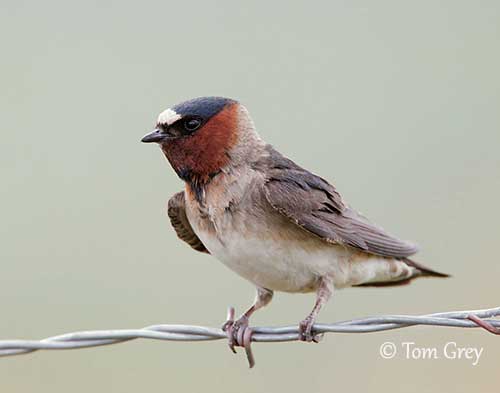
The juvenile is duller and browner than adults. It has darker forehead and ear-coverts, and the throat is usually paler but variable. On the upperparts, the feathers have pale margins, involving weak scaled pattern.
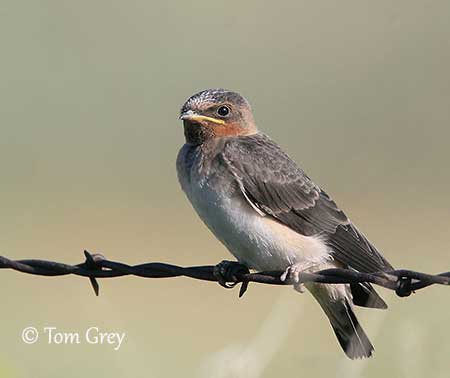
SUBSPECIES AND RANGE:
The Cliff Swallow has four subspecies that differ both in size and coloration.
P.p. pyrrhonota breeds in N America from W and C Alaska and Canada to S Quebec and Nova Scotia, S to NW Mexico (NW Baja California) in W, and in the E to E USA. It winters in S America.
P.p. tachina breeds in S USA, SW Utah S to C Arizona, C New Mexico and SW Texas, S to NW Mexico (Baja California). It probably winters in S America.
This race is smaller than nominate, with cinnamon to pale buff forehead.
P.p. melanogaster breeds in SE Arizona and SW New Mexico, S to S Mexico. It winters in S America.
This one is darker than “tachina”, with dark rufous-chestnut forehead and darker cinnamon rump.
P.p. ganieri breeds in S USA, W of Appalachians (WC Tennessee S to S Texas). It probably winters in S America.
This race has darker chestnut undertail-coverts, while rest of underparts shows pale chestnut tinge.
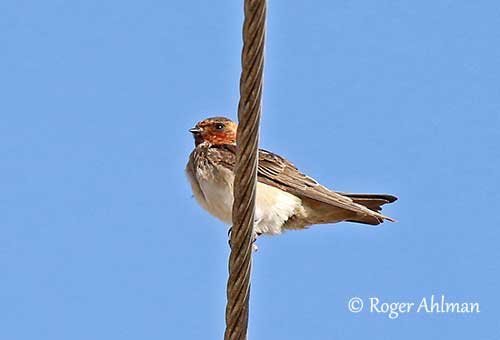
P.p. melanogaster
Ecuador
HABITAT:
The Cliff Swallow frequents open and semi-open areas, farmland, cliffs, usually near water such as rivers and lakes. It may occur from prairies to desert rivers, and in clearings in northern forests. It feeds mostly in open areas such as meadows, marshes and grasslands, but it roosts in wetland vegetation.
It needs sheltered, vertical cliffs for breeding, or other sites such as bridges and buildings. It also needs water with wet mud supply in the vicinity of the colony.
This species can be seen to 2770 metres of elevation, sometimes higher, and up to 4000 metres on passage.
CALLS AND SONGS: SOUNDS BY XENO-CANTO
The Cliff Swallow gives constant squeaky chattering and twittering. The calls include a dry “chrri-chrri”, or more nasal “chreh”, a nasal “jeh-jeh”, a slightly blurry, nasal “rrih” and a lower “rreh”.
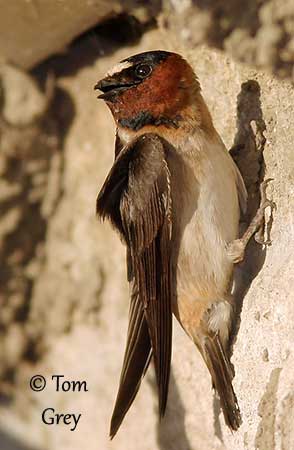
BEHAVIOUR IN THE WILD:
The Cliff Swallow is an insect-eater all year round and a diurnal feeder. It feeds on the wing above farmland, canyons and towns. It often forages in flocks low over water or very high over other habitat types.
It feeds on numerous insects including beetles, true bugs, flies, flying ants, bees and wasps. It also takes larger items such as grasshoppers, mayflies and lacewings, and spiders. It may occasionally consume some berries.
The Cliff Swallow feeds mainly in the air in warm weather, but lower in cool weather. It also feeds on ants on the ground.
They gather in large numbers at insect swarms, and they use a special call to attract others at rich food sources.
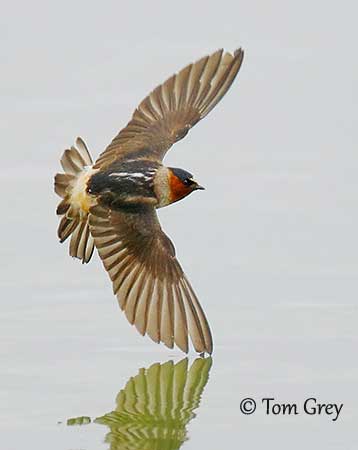
Once arrived at the breeding site, the male advertises and defends the territory by singing and flying in circle over the nest-site, before entering the nest and singing from the entrance.
The potential mate is gradually accepted, and they copulate inside the nest, preceded by a short invitation display during which the male moves to the back of the nest and calls softly. The copulation is often followed by preening.
The Cliff Swallow is socially monogamous, but extra-pair copulations are common as the male does not guard the female away from the nest. Extra-pair copulations often occur at mud-gathering sites. Both parents share the nesting duties.
The Cliff Swallow is a long-distance migrant. They migrate in large flocks and leave the breeding grounds in July/September, with peak in August/early September. They reach their wintering areas between October and December. The winter range is mainly E of Andes, from SE Paraguay and SE Brazil, S to C Argentina, rarely in Ecuador and Peru.
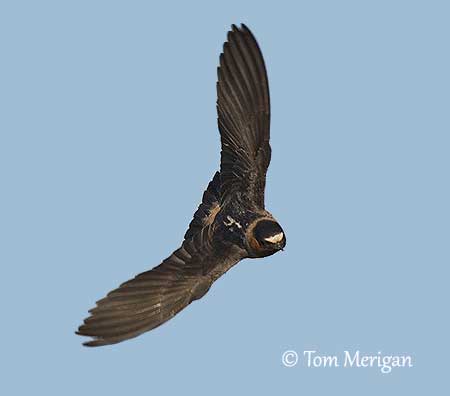
The return migration occurs between February and April, but later, mostly mid-May, in Alaska. The race “melanogaster” returns 6-8 weeks later than other races.
This species is vagrant in Siberia, Wrangel Island, the Aleutians, N Alaska, Newfoundland and Greenland, Caribbean, Falkland Islands and Europe (British Islands and France).
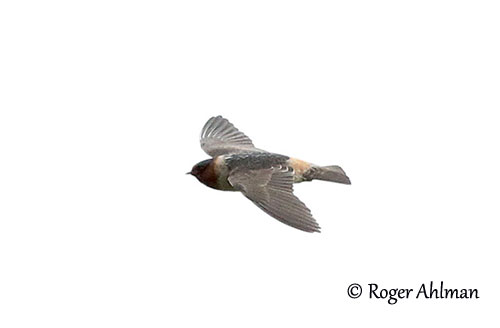
P.p. melanogaster
Ecuador
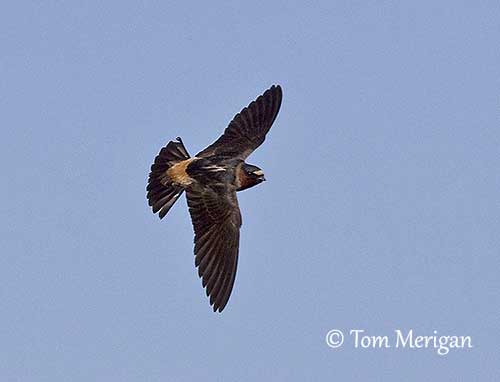
REPRODUCTION OF THIS SPECIES:
The breeding season takes place from April/May to July/early August. This species usually produces a single brood per season, rarely two.
The Cliff Swallow nests in colonies of 200-400 pairs and sometimes more. The nesting site is usually a vertical surface such as cliff, bridge or building, protected from above by overhang or ledge. The mud nests adhere best to rough rock or cement, or weathered board.
The nest is made of hundreds of dried mud pellets and it is gourd-shaped with a large chamber and a small entrance. The chamber is sparsely lined with grass and feathers. Both adults build the nest. However, an old nest can be repaired and reused.
The male often initiates the nest-building and carries pellets of mud in the bill to the nest-site. The mud is collected in the vicinity of the colony, at lakes or river shores. A bird remains at nest while the other is out gathering mud. The Cliff Swallow’s nest may contain between 900 and 1200 mud pellets, and one week is required to build it.
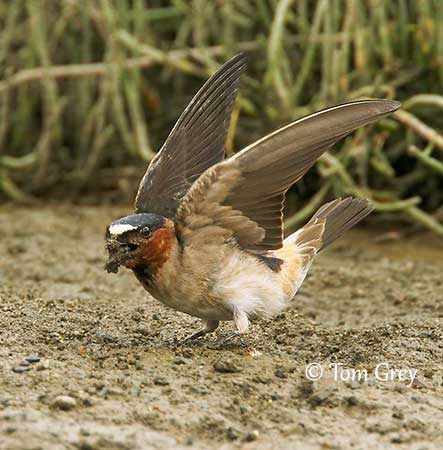
The female lays 3-6 white to pale pinkish eggs with brown spots. Both adults incubate during 14-16 days. The chicks are brooded continuously during the first 2-3 days. They are fed by both parents on small insects, and after a week, they receive the adult diet. They fledge 21-23 days after hatching, and still depend on parents for food for some days.
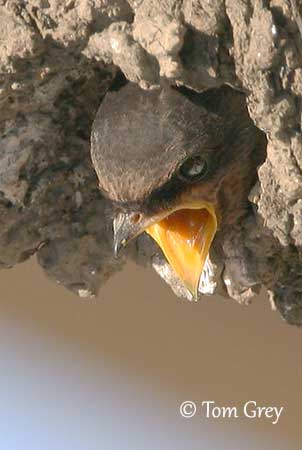
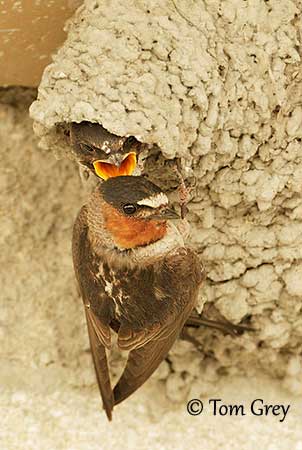
The young from several colonies form crèches of up to 1000 individuals perched in trees, wires and cliffs, at some distance from the nest, up to 2-3 kilometres. Parents and chicks communicate by calls for recognition, and the facial markings are probably useful too.
Ectoparasitism by swallow bugs (Oeciacus vicarius) is the main cause of chick mortality. The bugs assemble in empty swallow nests in April, and when the migrating birds return to their nests, the bugs take blood meals.
PROTECTION / THREATS / STATUS:
The Cliff Swallow is usually common in much of range. The breeding range has expanded in USA, due to new bridges and buildings, and increase of human settlements.
However, the swallow bugs and the introduced House Sparrow cause chick and nest loss.
The population has not been quantified, but it is suspected to be increasing.
The Cliff Swallow is currently evaluated as Least Concern.